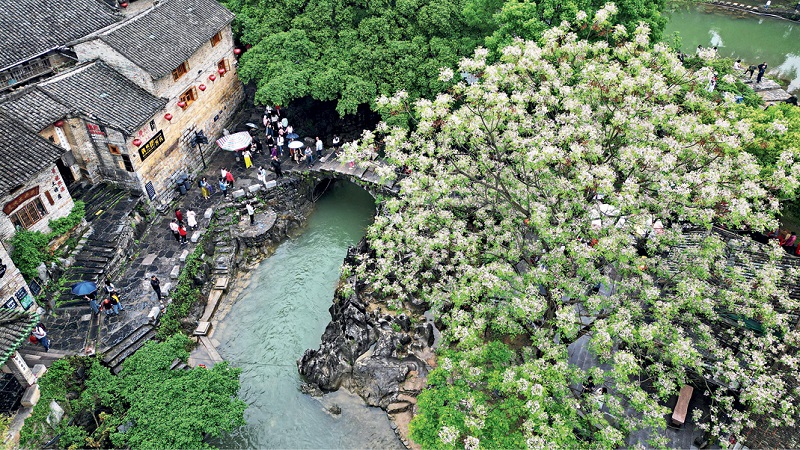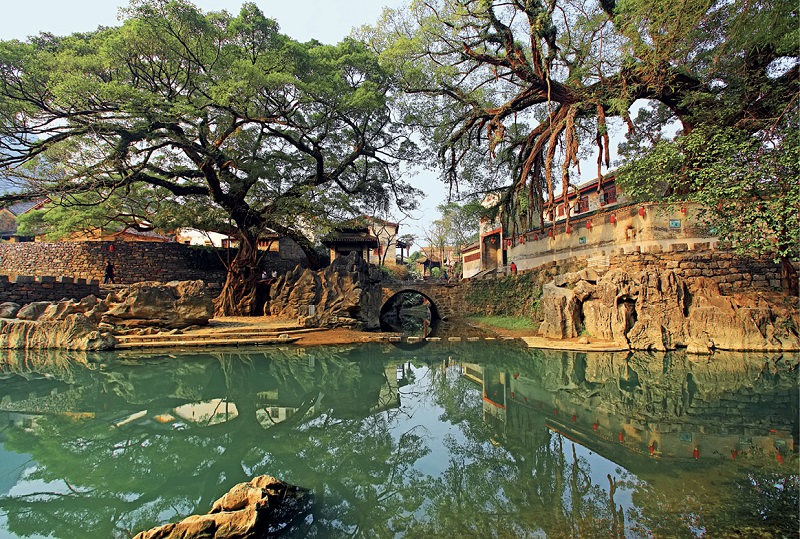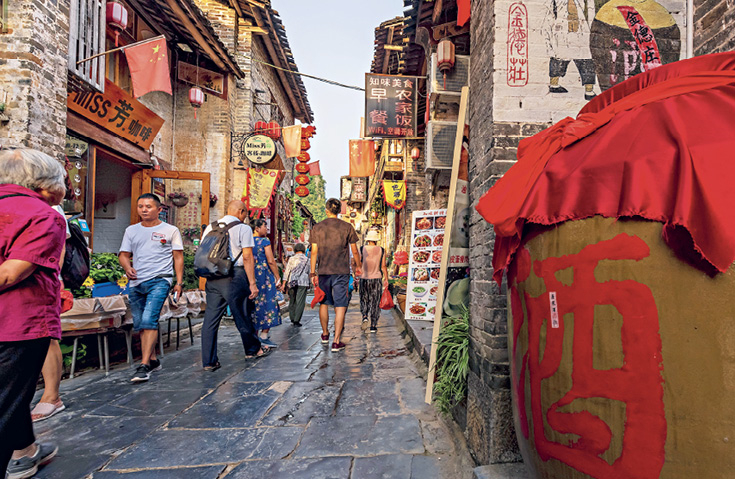
An aerial view of a scenic landscape featuring the famous Dailong Bridge on April 11, 2024.
Huangyao Ancient Town is located in the northeast of Zhaoping County in Hezhou City, south China’s Guangxi Zhuang Autonomous Region. Around 60 kilometers from downtown, the ancient town covers an area of over 3.2 square kilometers. It traces its origin to the early days of the Song Dynasty (960-1279). The town expanded during the Ming Dynasty (1368-1644) and flourished during the Qing Dynasty (1644-1911).
Stone bridges, meandering rivers, towering banyan trees, slab-paved ancient streets, and residential complexes enclosed by high walls are some of the features of this time-honored town. In 2022, Huangyao Ancient Town was recognized as a state-level 5A-rated tourist attraction.
Huangyao was built on a vast stretch of fertile land in a valley, where Zhenwu Mountains to its east block the cold and moist air coming from the northeast, giving the mountains a sacred status among local residents. Water is the lifeblood of the town as the Yaojiang River, Small Pearl River and Xingning River converge here, providing a source of sustainable water and acting as a natural defensive barrier.

Banyan trees cast a shadow over the land in the evening in Huangyao.
Defense Works
There are more than 300 surviving buildings from the Ming and Qing dynasties in this small town, making it one of the best-preserved and largest ancient towns in Guangxi. Apart from the natural barrier of rivers and hills, the hundreds of years of peaceful development of the town is attributed to its wisdom of preventing attacks and aggression.
Back in the Ming and Qing dynasties, most families in Huangyao were quite wealthy from merchant businesses, so they attached importance to town and housing fortification, with the purpose of defending themselves against enemy attackers and burglars. As a result, the town has a sophisticated design, equipped with superb defensive attributes.
There are four main gates to the town and street gates to each street. The eight streets are linked to the main street, and were all built with T-intersections rather than intersections, developing a maze-like system.
The East Gate Tower, dating back to the early Qing Dynasty, is the best preserved and most secure gate tower in Huangyao. Designed with openings for looking out, the tower acted as a defensive structure, while the Yaojiang River served as a moat.
The design of traditional local residential complexes also shows a strong awareness of defense. A typical aspect of this philosophy is that families in the same clan tended to build their houses around an ancestral hall, so that the they were close enough to care for and support each other.
The Guo’s Residence is one of the best-preserved residential complexes in Huangyao. Covering an area of over 500 square meters, it is a typical courtyard-style dwelling and dates back to the late Qing Dynasty. The residence mainly consists of a front hall, a courtyard, a main hall and several bedrooms. In the past, a plaque was presented by the imperial court during the reign of Daoguang Emperor in the Qing Dynasty, applauding the Guo family’s harmonious family environment. This plaque remains in the complex.
A highlight of this attraction is a wooden security door — three long wooden poles are inserted into corresponding holes in the door frame and a lever on the top initiates a mechanism to lock the poles in place, so that no one can open the gate from the outside. The high walls that enclose the complex have many small openings for lookout purposes and specifically designed places for armed residents to defend themselves against invaders.

Local residents are doing laundry at the Xianren Ancient Well in Huangyao Ancient Town.
Xianren Ancient Well
Among around a dozen wells in Huangyao, one named Xianren Ancient Well, literally meaning immortal ancient well, is a major drawcard for visitors. The well was built in the late Ming Dynasty next to the Xingning River and these two water bodies almost meet. Legend has it that seven immortals were once seen relaxing by the well, giving the well its name. This one-meter-deep well is composed of five separate but linked square wells whose water all comes from the same spring. Each well was assigned a unique purpose. The first well is for drinking, second for washing cooking ingredients, third and fourth for washing hands and doing laundry, and fifth for cleaning household products and agricultural tools. The well water flows across the five wells and finally meets the Xingning River from the fifth well.
Its source of water is a natural spring that originates from a nearby hill. The water is clear and sufficient. Its temperature remains at 18 Celsius degrees all year round. Scientific testing has shown that the underground water in Huangyao is rich in minerals. The town has been known for having many elderly people who are over 100 years old, and attribute their longevity to drinking the well water.
Bridges
Dailong Bridge is a must-visit attraction in Huangyao. It is the largest stone bridge in the town and dates back to the late Qing Dynasty. It is said that the bridge was built to transport the sacred air of Zhenwu Mountains to the village streets.
The stone bridge, without any banisters, blends in perfectly with its surroundings, displaying distinct landscaping anesthetics. Stones were paved in a purposefully untidy manner around on an inconspicuous bank, a stone wall was built nearby, and Dailong Bridge was constructed beside the wall. The combination of untidily arranged stones, a river, a bridge and a wall creates a serene and pleasant landscape if it is viewed from a distance. The elegant two-arched bridge is also practical for protection against flooding, with a smaller arch designed for diverging floodwater.
Shitiao Bridge is a distinct bridge in Huangyao, going back to the mid-Qing Dynasty. This 19-meter-long bridge is composed of 31 separate stepping stones. The width between each stone is suitable for an adult to take a step or a small jump. In this way, it is convenient for people to cross the river. At the same time, the design doesn’t affect any flowing floodwater.
Old Banyan Trees
There are several ancient banyan trees that are hundreds of years old in Huangyao. The Dragon Claw Tree, more than 850 years old, is one of the oldest banyan trees in Huangyao. Its thick trunk almost grows horizontally close to water level and numerous aerial roots and branches extend in all directions, looking like the claws of a huge fierce dragon. Most of its branches are dead and withered while the trunk remains alive.
Besides the Dragon Claw Tree, the Longmen Tree is also more than 800 years old. Growing on stones, its tree branches grow and are wildly bent by the wind, forming an “arch.” Another famous banyan tree is named the Couple Tree. It is 300 years old, and looks like one tree but is actually a combination of two trees. In times of drought or flooding, its leaves turn yellow, alerting local residents to prepare accordingly.

People in Huangyao are walking down an old bluestone street which is now lined with all kinds of stores.
Old Bluestone Streets
There are eight streets paved with bluestone in the town, dating back to the late Qing Dynasty. The total length is three kilometers. The slabs were firmly placed without the use of any adhesives between them, relying only on exact dimensions. Interconnected drainage channels were arranged beneath each street, allowing rain water to flow out of the town, which effectively solves the drainage problem. This system reflects the intelligence of Huangyao’s craftsmen and planners.
In recent years, in order to better protect the historic town, the local government has invited a group of experts to repair old streets, gate towers, theaters, and residential buildings to their original state. At the same time, local residents began to turn their remodeled old houses into vacation rentals or specialty stores, to help the old town take on a new lease of life in the modern era.